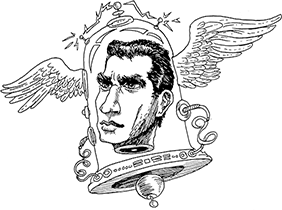On July 8, 2000, a man was loaded into an ambulance, packed in with dozens of Ziploc bags of ice cubes, and rushed onto the long flight from New York City to Scottsdale, Arizona. Several hours earlier, he’d been pronounced clinically dead, but on the ground a team of technicians had rallied around his cancer-riddled cadaver with great optimism.
At the Alcor Life Extension Foundation, they laid out the body—now patient A-1261—on an operating table encased in a coffin-shaped Plexiglas box. To keep the temperature down, the technicians pumped the box full of hyper-cold nitrogen gas, maintaining A-1261 in what they believed to be a liminal state—on pause. They worked so feverishly to preserve the body because it belonged to one of their champions. A-1261 was (and, they hoped, would someday become again) one of the world’s most celebrated transhumanists, a prominent member of a loose collective of futurists working in philosophy, science, and technology to realize humankind’s full potential, with the ultimate goal of shrugging off the shackles of aging and death. At Alcor, the Holy See of cryonics, the attendants were of the same tribe, and this is how you die if you’re one of them: an impermanent death, your mind and all the radical ideas contained therein “cryopreserved” until a distant, far more evolved Future is ready to grow you a new body and embrace you as your Phase Two, cyborg self. A transhumanist’s death is merely a pit stop on the way to his inevitable resurrection.
The surgeons inserted their bright blue rubber-gloved hands through mail-slot openings in the Plexiglas to tend to the vessel. They cut deeply with the scalpel, then identified the precise spot—between the sixth and seventh vertebrae—and with a chisel and a mallet lopped off the head of Fereidoun Esfandiary.
*
In what he would call his “animal-human” life—his life as a “biological accident,” a “bad robot”—patient A-1261 was known by another collection of initials and numbers: FM-2030.
FM-2030 was “launched” in Brussels in 1930, under the name Fereidoun M. Esfandiary. The son of an Iranian diplomat, Esfandiary was educated in Iran, England, and Israel; spoke Arabic, Hebrew, English, and French; and had lived in seventeen countries before he turned twelve. From a young age, he was a man with wide-ranging allegiances and multiple identities. He attended high school at a multilingual Palestinian Jesuit school in Jerusalem, where he waited for something glamorous to latch on to. He filled a notebook with lists of Hollywood studios, their addresses and stars, their names written in perfect, curling penmanship: Joan Crawford, Clark Gable, Hedy Lamar. At the age of seventeen, Esfandiary was propelled into an even larger world, invited to represent Iran...
You have reached your article limit
Sign up for a digital subscription and continue reading all new issues, plus our entire archives, for just $1.50/month.
Already a subscriber? Sign in





